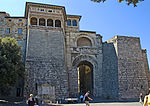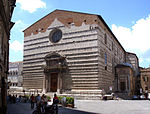San Bevignate
13th-century Roman Catholic church buildings in ItalyChurches completed in 1250Knights TemplarRoman Catholic churches in Perugia

San Bevignate is a church in Perugia, Umbria, central Italy. It dates to the mid 13th century, and was expanded by the Knights Templar in the 1280s. It is notable for its 13th-century frescoes. It is named for San Bevignate, the local patron saint of the flagellant movement.
Excerpt from the Wikipedia article San Bevignate (License: CC BY-SA 3.0, Authors, Images).San Bevignate
Via Enrico dal Pozzo, Perugia Sant'Erminio
Geographical coordinates (GPS) Address External links Nearby Places Show on map
Geographical coordinates (GPS)
| Latitude | Longitude |
|---|---|
| N 43.1106 ° | E 12.4093 ° |
Address
San Bevignate
Via Enrico dal Pozzo 145
06126 Perugia, Sant'Erminio
Umbria, Italy
Open on Google Maps









